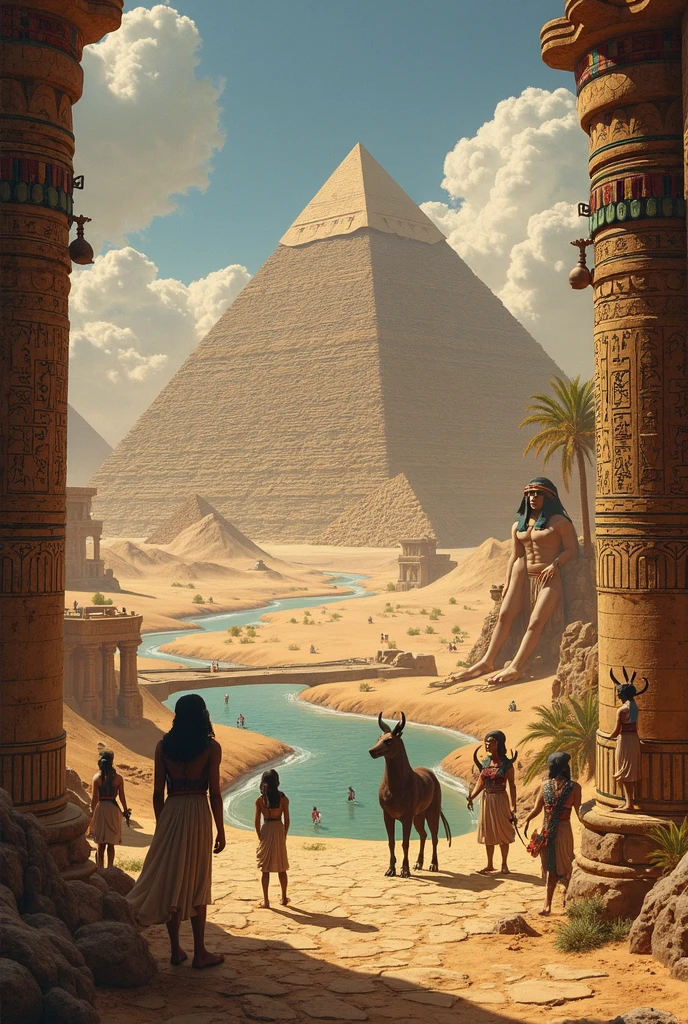Guaraní Mythology: The Legends of Ñamandú and the Jungle Gods
The rich tapestry of Guaraní mythology is filled with powerful deities, mystical creatures, and stories of creation that have been passed down through generations. At the heart of these legends stands Ñamandú, the supreme god who shaped the world alongside other divine beings like Tupá and Ñandecy. This article explores the fascinating world of Guaraní myths, their connection to the jungle, and the symbolic role of the jaguar in their cosmology.
The Creation Myth: Ñamandú and the Birth of the World
According to Guaraní tradition, Ñamandú is the primordial creator who emerged from chaos to bring order to the universe. Unlike other creation myths, Ñamandú did not work alone—he was accompanied by other deities who helped shape the earth, sky, and all living beings.
Key Figures in Guaraní Creation
- Ñamandú – The supreme god, representing light and wisdom.
- Tupá – The god of thunder and storms, often associated with strength.
- Ñandecy – The mother goddess, symbolizing fertility and nature.
- Jaguar – A sacred animal representing power and the untamed jungle.
The Pantheon of Guaraní Deities
The Guaraní people worshipped a diverse pantheon, each deity playing a crucial role in their cosmology. Below is a table summarizing the most important gods and their domains:
| Deity | Role | Symbol |
|---|---|---|
| Ñamandú | Supreme Creator | Sun, Light |
| Tupá | God of Thunder | Lightning, Storms |
| Ñandecy | Mother Goddess | Earth, Fertility |
| Jaguar | Guardian Spirit | Strength, Wilderness |
The Sacred Jungle in Guaraní Beliefs
The jungle was not just a physical space for the Guaraní—it was a living entity filled with spirits and divine energy. Many myths describe how the gods shaped the forests, rivers, and mountains, making them sacred places where humans could commune with the divine.
Mythical Creatures of the Jungle
- Mbói Tu’ĩ – A giant serpent linked to water and rain.
- Pombero – A mischievous forest spirit.
- Kurupí – A mythical being with an elongated phallus, symbolizing fertility.
The Role of the Jaguar in Guaraní Mythology
The jaguar held a special place in Guaraní culture as a symbol of power and protection. Unlike in other mythologies where the jaguar is feared, the Guaraní saw it as a guardian spirit that could communicate between the human and divine realms.
For further reading on indigenous myths, check out these resources: Encyclopedia Britannica on Guaraní, Smithsonian on Indigenous Myths, and National Geographic on Guaraní Culture.
Discover more fascinating articles on mythology and culture by following us on facebook.com/zatiandrops.
The Legend of the First Humans: Rupave and Sypave
According to Guaraní tradition, the first humans were not created by Ñamandú alone. Instead, they emerged from a sacred union between the divine and earthly realms. Rupave (Father of the People) and Sypave (Mother of the People) were molded from clay by Ñandecy, infused with the breath of life from Tupá, and granted wisdom by Ñamandú himself. This myth explains the Guaraní belief in humanity’s dual nature—part earthly, part divine.
Symbolism in the First Humans’ Creation
- Clay – Represents humanity’s connection to the earth.
- Divine Breath – Symbolizes the soul and spiritual essence.
- Jaguar’s Roar – The sound that awakened their consciousness, linking humans to the jungle’s power.
The Celestial War: Tupá vs. Añá
One of the most dramatic tales in Guaraní mythology is the eternal struggle between Tupá, the god of order, and Añá, the spirit of chaos. Unlike Western dualism where good and evil are strictly separated, Guaraní myths portray this conflict as a necessary balance. Añá wasn’t purely malevolent—his disruptions forced Tupá to innovate, leading to the creation of new animals, plants, and even weather patterns.
| Event | Tupá’s Role | Añá’s Influence |
|---|---|---|
| Creation of Rivers | Designed flowing water for life | Caused waterfalls and rapids as challenges |
| Shaping Mountains | Provided stable land | Introduced earthquakes to test resilience |
| Animal Diversity | Created gentle creatures | Added predators to maintain balance |
Rituals and Ceremonies: Communicating with the Gods
The Guaraní developed intricate rituals to honor their deities, often involving music, dance, and sacred plants. One key ceremony was the Avatiky (Corn Festival), where offerings of maize were made to Ñandecy to ensure fertile harvests. Shamans, known as Payés, acted as intermediaries, entering trances to receive messages from the spirit world.
Sacred Plants in Guaraní Rituals
- Yerba Mate – Used in communal ceremonies to promote unity.
- Ayahuasca (known as Caapi) – Facilitated visionary journeys to the divine realm.
- Tobacco – Smoke carried prayers to the gods.
The Lost City of Ivytú: A Mythological Paradise
Many Guaraní legends speak of Ivytú, a hidden city deep in the jungle where the gods once dwelled among humans. Unlike Atlantis, Ivytú wasn’t destroyed—it simply vanished when humanity grew corrupt. Some myths claim it still exists, protected by jaguar spirits and visible only to those pure of heart. This belief fueled numerous expeditions during the colonial era, though none succeeded in finding it.
Characteristics of Ivytú
- Golden Pyramids – Said to glow with Ñamandú’s light.
- Singing Trees – Their melodies could heal the sick.
- Water of Immortality – A spring guarded by the Mbói Tu’ĩ serpent.
The Seven Legendary Prophecies of the Guaraní
Guaraní oral tradition preserves a series of prophecies foretold by the Payés. These weren’t doom-laden warnings but guidance for maintaining harmony with nature and the gods. The most famous prophecy predicts the return of Tupá during a great flood, where he will separate the worthy from the corrupt by testing their respect for the jungle.
| Prophecy | Sign | Modern Interpretation |
|---|---|---|
| First Prophecy | When the jaguar weeps | Deforestation crises |
| Third Prophecy | Rivers flowing backwards | Climate change altering water cycles |
| Seventh Prophecy | The “great fire in the sky” | Potential solar flares or cosmic events |
Guaraní Star Lore: Constellations as Divine Messengers
Unlike Western astrology, Guaraní celestial mythology views constellations as animal spirits sent by Ñamandú to guide humanity. The Eichu (Jaguar constellation) was believed to protect travelers, while the Mboi (Serpent constellation) warned of coming storms. Astronomers have noted these alignments often match actual star patterns in the Southern Hemisphere.
Key Guaraní Constellations
- Yvaga (The Sky Jaguar) – Associated with Orion’s Belt.
- Ñamandú Rupavẽ (Creator’s Path) – The Milky Way, seen as a celestial river.
- Tupã Mbara (Tupá’s Net) – A cluster representing divine justice.
For deeper insights into indigenous astronomical traditions, explore BBC’s article on star lore, ScienceDaily’s research on indigenous astronomy, and History.com’s feature on Native American sky knowledge.
Discover more fascinating articles on mythology and culture by following us on facebook.com/zatiandrops.
The Myth of the Eternal Fire: Tupá’s Gift to Humanity
One of the most revered legends in Guaraní mythology tells how Tupá gifted fire to humans through the bravery of a young warrior named Jasy (Moon). According to the tale, fire was originally kept by the gods atop the sacred mountain Yvytyruzú, guarded by the Jaguar spirits. Jasy climbed the mountain, tricked the jaguars with a dance, and stole an ember hidden inside a glowing fruit. This myth explains not only the origin of fire but also the Guaraní tradition of maintaining eternal flames in their temples.
Symbolic Elements in the Fire Myth
- Yvytyruzú Mountain – Represents the connection between earth and heaven.
- Glowing Fruit – Symbolizes divine knowledge and transformation.
- Jaguar Guardians – Embody the protective yet dangerous nature of sacred forces.
The Water Pantheon: Gods of Rivers and Rain
Beyond Mbói Tu’ĩ, the Guaraní worshipped a complex hierarchy of water deities who controlled different aspects of aquatic life:
| Deity | Domain | Sacred Animal |
|---|---|---|
| Ypakaré | River currents | Golden fish |
| Yacy | Moon & tides | White heron |
| Arasy | Rainstorms | Thunderbird |
The Dance of the Moons: Guaraní Lunar Calendar
The Guaraní tracked time through 13 lunar cycles, each named after significant ecological or spiritual events. This calendar dictated planting, hunting, and ceremonial activities with remarkable precision:
- Jasy Tenonde (First Moon) – Marks the beginning of spring
- Jasy Jate’i (Honey Moon) – When bees become active
- Jasy Tuja (Old Moon) – Time for harvesting medicinal plants
The Legend of the Hummingbird Messenger
In Guaraní cosmology, the Mainumby (hummingbird) serves as a divine messenger between worlds. One myth describes how Ñamandú transformed a brave warrior into the first hummingbird to carry prayers to the gods. This explains why seeing a hummingbird near one’s home is considered an auspicious sign even today.
Hummingbird Symbolism
- Rainbow Colors – Represent the bridge between earthly and spiritual realms
- Rapid Wingbeats – Symbolize the fleeting nature of divine messages
- Nectar Feeding – Associated with spiritual nourishment
The Cave of Voices: Where Ancestors Whisper
Deep in the jungle, the Guaraní believe there exists Itá Cué (Stone House), a cave where the voices of ancestors can be heard whispering through stalactites. Shamans visit this sacred site to consult with past generations, particularly during times of drought or conflict.
Characteristics of Itá Cué
- Echoing Chambers – Amplify spiritual communications
- Luminous Crystals – Said to contain trapped moonlight
- Jaguar Paw Prints – Etched in stone as guardian symbols
The Forbidden Fruit: Guaraní Version of the Temptation Myth
Unlike the biblical story, the Guaraní temptation myth involves Ñandecy warning humans against eating the fruit of the Yvapurũ tree. When a curious woman tasted it, she gained profound knowledge but lost the ability to communicate with animals—explaining humanity’s separation from nature in Guaraní philosophy.
| Element | Biblical Parallel | Guaraní Difference |
|---|---|---|
| Forbidden Fruit | Causes fall from grace | Brings knowledge but severs natural harmony |
| Consequence | Expulsion from Eden | Loss of animal communication |
For more comparative mythology studies, visit World History Encyclopedia, Native Languages Project, and The Met’s Indigenous Art Collection.
Discover more fascinating articles on mythology and culture by following us on facebook.com/zatiandrops.
The Sacred Chants of the Guaraní: Language as Divine Power
In Guaraní mythology, spoken words carried creative energy. The Ñe’ẽ Porã (Beautiful Words) were sacred chants believed to have been taught by Ñamandú himself. Shamans used these phonetically precise invocations to heal the sick, summon rain, or even temporarily transform into jaguars. Modern linguists note how the Guaraní language preserves these ancient tonal patterns in ceremonial contexts.
Types of Sacred Chants
- Purahéi Jaikuaa – Knowledge songs for transmitting myths
- Purahéi Pohã – Healing chants with plant spirit invocations
- Purahéi Jagua – Jaguar transformation verses
The Floating Islands: Mystical Geography of the Guaraní
Several myths describe Ypa’ũ – enchanted floating islands that drift across wetlands and rivers. These weren’t physical landmasses but spiritual waystations where souls rested before ascending to Ñamandú’s celestial realm. The concept may have originated from actual floating vegetation islands common in the Pantanal region.
| Island Name | Spiritual Purpose | Associated Deity |
|---|---|---|
| Ypa’ũ Morotĩ | Purification of warriors | Tupá |
| Ypa’ũ Hovy | Healing of broken hearts | Ñandecy |
| Ypa’ũ Jaguarete | Testing of shamans | Jaguar spirits |
The Origin of Night: How the Bat Stole Darkness
Unlike most cultures that associate bats with darkness, Guaraní myths credit the Mbopi (bat) for bringing night to the world. In this lesser-known creation tale, the primordial world had constant daylight until the bat tricked Ñamandú into revealing the secret of darkness hidden in a gourd. When the bat released it, the first sunset occurred – explaining both the day/night cycle and why bats only emerge at dusk.
Symbolic Meanings in the Bat Myth
- The Gourd – Represents hidden knowledge
- Winged Messenger – Bat as mediator between light/dark realms
- Twilight – Sacred time for spirit communication
The Warrior Cult of Tupá: Guaraní Martial Traditions
Historical accounts describe how Guaraní warriors invoked Tupá’s thunder power before battles through elaborate rituals:
- Three-day fasting in the jungle
- Application of sacred jaguar face paint
- Chanting while striking weapons against quartz stones to create sparks
- Consumption of warrior’s brew made from yerba mate and chili peppers
The Weeping Tree: Botanical Mysticism
The Yvyrá Ñe’ẽ (Speaking Tree) appears in multiple Guaraní myths as a sacred kapok tree that wept resin tears containing prophecies. Shamans would collect these amber-like droplets during full moons to interpret divine messages. Modern botanists confirm that the kapok (Ceiba pentandra) does produce copious resin during certain lunar phases.
| Tree Feature | Mythological Meaning | Scientific Basis |
|---|---|---|
| Buttress Roots | Pathways for earth spirits | Actual root structures |
| Resin Tears | Crystallized prophecies | Natural latex production |
| Canopy Height | Connection to celestial realm | Grows over 200 feet tall |
The Rainbow Serpent’s Gift: Origin of Guaraní Textiles
Legend tells how the Mbói Chumbe (Rainbow Serpent) taught Guaraní women to weave by spitting colored threads from its mouth. This explains the intricate geometric patterns in traditional Ñandutí lacework, which preserve sacred designs representing:
- Jaguar paw prints
- Constellation maps
- River current patterns
For deeper exploration of indigenous textile traditions, see Textile Museum resources, UNESCO’s Nandutí documentation, and Smithsonian Folkways research.
Discover more fascinating articles on mythology and culture by following us on facebook.com/zatiandrops.


